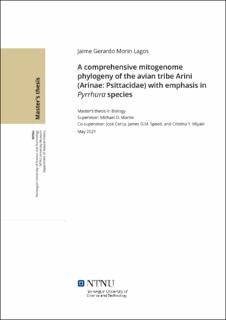| dc.description.abstract | The tribe Arini is the most diverse group of Neotropical parrots, and it includes approximately 158 species distributed in at least 32 genera. These parrots have been largely affected by habitat loss, fragmentation, and the illegal wildlife trade market. In the past, many molecular phylogenies have been inferred based on both nuclear and mitochondrial sequences. However, the evolutionary relationships between some taxa remain unclear, especially within the Pyrrhura genus, the most diverse genus within the tribe. This study used whole-genome shotgun sequencing to obtain mitochondrial genome sequences of 48 Pyrrhura samples, representing 22 Pyrrhura species. Using this data together with all publicly available mitogenome sequences, we inferred the most comprehensive mitogenome-based phylogeny of the tribe Arini. The obtained phylogeny shows better resolved clades and higher support than previous phylogenetic studies of Arini and Pyrrhura. Previous studies categorized Pyrrhura species in three groups, including P. cruentata, the picta-leucotis complex, and the ‘remaining Pyrrhura species’. The evolutionary relationships within the last two groups have been poorly studied so far. Based on our mitogenome phylogeny, we divide the ‘remaining Pyrrhura species’ into the following groups: Clade 1: P. rupicola; clade 2: P. frontalis, P. molinae, P. perlata, and P. lepida; clade 3: P. hoffmani, and P. rhodocephala; clade 4: P. egregia, P. calliptera, and P. melanura. Previous works placed P. albipectus and P. devillei in clades 4 and 2 respectively. On the other hand, the P. orcesi could form an independent clade within the remaining Pyrrhura species. The systematic positions of P. viridicata and P. hoematotis remain a mystery due to lack of data. hoematotis remain a mystery due to lack of data. Finally, a CYTB-CR-based phylogeny was inferred to further study the relationships within the clade 4 of the ‘remaining Pyrrhura species’, finding that P. melanura taxa form two separate clades. The first includes P. melanura taxa from Venezuela: P. m. souancei, P. calliptera, and P. albipectus. The second includes P. melanura taxa from Western South America, P. m. berlepschi, and P. m. pacifica. Moreover, species distribution models (SDMs) provided further support to the isolation of P. m. souancei and P. m. pacifica from the nominal race. Our results suggest that P. melanura subspecies are geographically and genetically separated from the nominal race. Future studies should increase the sample size and involve morphological analysis. | |
